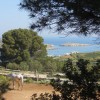
This statue was inaugurated in 1845 and stands 4m high. It is thought to be located near the spot where St Paul was shipwrecked in 60 AD.
In April 1994, two members of the Youth Section of Din l-Art Helwa, Stanley Farrugia Randon and Ian Galea, prepared a Condition Survey for a thorough clean-up of St Paul’s Island. Two months later an expedition was organised and twenty large bags of litter were collected, and many pieces of barbed wire were removed. It was noticed that the statue was extremely weather-beaten and the left arm was about to fall off. The uplifted hand, which was not the original one, had two fingers missing.
In 1996 Din l-Art Helwa took over the responsibility of restoring the statue. The restorer Godwin Xuereb from Rabat worked on this project in conjunction with architect Michael Ellul. Cement wash was removed from the statue and a special mortar was used to seal all cavities and reconstruct the missing parts. The marble inscription on the pedestal had to be replaced and a faithful replica was produced at the government marble workshop in Valletta.
Din l-Art Helwa subsequently restored the statue, and Nazzareno Vassallo, chairman of Vassallo Builders Group of Mosta, agreed to sponsor the initiative. This was done on the 50th anniversary of Vassallo Builders Group of Companies.
Since then the statue again suffered damages from weathering due to the adverse environmental condition that it is exposed to. Vassallo Builders Group of Companies celebrated its 60th anniversary in 2007 and again offered to sponsor the whole conservation of the statue, as well as the laborious task of erecting the scaffolding around it.
The second restoration of the statue was inaugurated on 13th October 2007, by Martin Galea, Executive President of Din l-Art Helwa, and Nazzareno Vassallo, Chairman of Vassallo Builders.
Dr Stanley Farrugia Randon was the promoter and project leader, and architect Dr David Mallia supervised the restoration on behalf of Din l-Art Helwa.
The work mainly involved the cleaning, treatment and presentation of the statue, with superficial cleaning of surface deposits. The conservation process of studying, documenting and treating the statue was undertaken by a team of qualified and experienced conservator-restorers – Ingrid Ross, James Licari and Frank Chetcuti.
The large statue of St Paul on St Paul’s Island is the work of two sculptors, Sigismondo Dimech (1780-1853) of Valletta and Salvatore Dimech (1805-1887) of Lija, a scholar of Sigismondo. Both of these masons created many other artistic works. The statue alone is about 4m high and represents St Paul holding a book in his left hand while holding up the right hand. At his feet lies the snake which, according to the Acts of the Apostles, came out of the fire and bit his hand. The statue stands on a platform 8.3m high, which is the work of Francesco Spiteri. The stones are second-grade travertine, and for every four orders of height, pieces of stone shaped like a chain were affixed. The mixture required to fill in the joint lines of the stones is made up of lime mortar, sand and fabricated cement with puzzolana of first quality[1]. On the platform a marble slab was fitted with the following words chosen by the Latinist Dun G. Zammit (aka ‘Brighella’):
‘To the Apostle St Paul, Master and Doctor of the Church of all People, Father and Patron of the Maltese. This statue is the same place where he was shipwrecked – together with 275 others – on this island where he had to come and teach the faith of Christ, as his friend St Luke says in the Acts of the Apostles Cap.XXVII. Salvatore Borg, in memory of this event – in the year 1845 – worked hard for its erection’[2].
The promoters of the fund-raising for the erection of the statue were Fr Francesco Caruana Dingli, Dr Michele Parnis, Filippo Busuttil, Vincenzo Spiteri, and Salvatore Borg, who was the most active among them. The costs of the platform, including the sculptor’s fees, amounted to 1,150 scudi[3]. The five large stones used for the construction of the statue cost 171 scudi, while the sculptors were paid 333 scudi. The promoters started collecting money for the statue in 1843, when they set up subscription lists. One list was for the nobility, judges and professionals, and another for residents of the Three Cities[4]. Various persons donated large sums of money and Salvatore Borg himself donated 100 scudi. He also allotted an amount of money for the maintenance of the statue.
A year before the statue was inaugurated in September 1844, work on the platform and statue was ready but only half of the money required was collected. It took another year to collect the whole amount. The statue was inaugurated and blessed on 21st September 1845 at 5 pm. The parish priest of Mellieha as well as clergy from St Paul`s church in Valletta were invited. Prayers were said and hymns were sung. The ceremony ended with the firing of cannon shots, after which the people returned home with kerosene lamps as it was already dark .






Comments are closed.